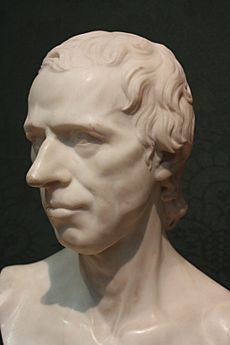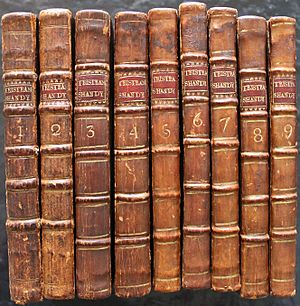Laurence Sterne facts for kids
Quick facts for kids
Laurence Sterne
|
|
|---|---|

Portrait by Sir Joshua Reynolds, 1760
|
|
| Born | 24 November 1713 Clonmel, County Tipperary, Ireland |
| Died | 18 March 1768 (aged 54) London, England |
| Occupation | Novelist, clergyman |
| Nationality | British |
| Alma mater | Jesus College, Cambridge |
| Notable works | The Life and Opinions of Tristram Shandy, Gentleman A Sentimental Journey Through France and Italy A Political Romance |
| Spouse | Elizabeth Lumley |
Laurence Sterne (born November 24, 1713 – died March 18, 1768) was a famous Anglo-Irish writer and a church leader. He is best known for his novels The Life and Opinions of Tristram Shandy, Gentleman and A Sentimental Journey Through France and Italy. He also published sermons and his own life story.
Laurence grew up in a military family, moving often, mostly around Ireland. His uncle helped him go to Hipperholme Grammar School in England. Later, he attended Jesus College, Cambridge, where he earned his degrees.
In 1741, while working as a vicar in Sutton-on-the-Forest, Yorkshire, he married Elizabeth Lumley. His early writing, a church satire called A Political Romance, caused some anger and was even burned. But this showed his talent for writing.
He then published the first parts of his most famous novel, The Life and Opinions of Tristram Shandy, Gentleman. Because he had a lung illness called tuberculosis, Sterne traveled to France to find a better climate. He wrote about his journey in A Sentimental Journey Through France and Italy, which came out just weeks before he died.
After his death, a journal called Journal to Eliza was published. It was written for Eliza Draper, a woman he had strong feelings for. Laurence Sterne died in 1768 and was buried in London. There's a story that his body was stolen and sold to scientists at Cambridge University, but then recognized and reburied.
Contents
About Laurence Sterne
Early Life and School

Laurence Sterne was born in Clonmel, Ireland, on November 24, 1713. His father, Roger Sterne, was an officer in the British army. Laurence's great-grandfather, Richard Sterne, had been a very important church leader, the Archbishop of York. However, Laurence's father was the youngest son of a youngest son, so he didn't inherit much money.
Roger Sterne joined the army at 25 and married Agnes Hobert, who was also from a military family. For the first ten years of Laurence's life, his family moved around a lot because his father was often sent to new army bases, mostly in Ireland. They lived in many different towns, never staying in one place for more than a year.
In 1724, when Laurence was almost eleven, his father took him to live with his wealthy brother, Richard, in England. This allowed Laurence to attend Hipperholme Grammar School near Halifax. Laurence never saw his father again, as Roger was sent to Jamaica and died there from malaria in 1731.
In 1733, at age 20, Laurence was accepted into Jesus College, Cambridge. He earned his first degree in 1737 and his Master of Arts degree in 1740.
Becoming a Clergyman and Writer
Sterne became a deacon in the church in 1737 and a priest in 1738. Soon after, he was given the job of vicar at Sutton-on-the-Forest in Yorkshire. In 1741, he married Elizabeth Lumley. Both of them were ill at the time with a lung disease.
Later, he also took on duties at a nearby church in Stillington. He was also a prebendary at York Minster, which is a large cathedral. Laurence's life was closely connected to his uncle, Jaques Sterne, who was also a powerful church leader. His uncle encouraged Laurence to write political articles. This caused some arguments and eventually led to a disagreement between them. Laurence stopped writing political articles in 1742.
He lived in Sutton for twenty years. During this time, he became good friends with John Hall-Stevenson, a lively and clever man who owned a large house nearby.
His Famous Books

In 1759, Sterne wrote a religious satire called A Political Romance. A satire is a type of writing that uses humor, irony, or exaggeration to criticize people's mistakes or foolishness. Many copies of this book were destroyed because it made some people angry.
At 46 years old, Sterne decided to focus on writing for the rest of his life. He was living in the countryside, trying to make money as a farmer, but also struggling with tuberculosis. It was during this time that he started writing his most famous novel, The Life and Opinions of Tristram Shandy, Gentleman. The first parts of this book were published in 1759.
He wrote very quickly, finishing the first 18 chapters in just a few months. Because he didn't have much money, he had to borrow funds to print his novel. This shows he believed his book would be a success and that local readers liked it.
When Tristram Shandy was published, it made Sterne famous in London and across Europe. He loved the attention, once saying, "I wrote not [to] be fed but to be famous." He spent part of each year in London, where he was celebrated as new parts of his book came out. He was happy that people bought his book, even if some criticized it. In 1760, he was given another church position in Coxwold, North Yorkshire.
In 1766, a former slave and composer named Ignatius Sancho wrote to Sterne. He asked Sterne to use his writing to help end the slave trade. Sterne's public reply to Sancho's letter became an important part of the movement to abolish slavery in the 1700s.
Travels Abroad

Sterne continued to suffer from his illness. In 1762, he left England for France, hoping the climate would help him feel better. He was lucky to join a group of diplomats going to Turin, Italy, because England and France were still at war.
Sterne was pleased with how he was welcomed in France. News of his brilliant novel Tristram Shandy had made him a celebrity there. Parts of this trip to France were later included in his second novel, A Sentimental Journey Through France and Italy.
Friendship with Eliza
In early 1767, Sterne met Eliza Draper. She was the wife of an official from the East India Company and was staying in London by herself. Sterne was quickly charmed by Eliza's lively personality and intelligence. She also seemed to enjoy the attention from such a famous writer.
They met often and exchanged small portraits. Sterne's admiration for her grew into a very strong feeling, which he didn't try to hide. To his great sadness, Eliza had to return to India three months after they first met. He died from his illness a year later, without seeing her again.
In early 1768, Sterne published A Sentimental Journey, which includes some special mentions of Eliza. Their friendship, though not romantic in a physical way, caused a lot of interest. He also wrote his Journal to Eliza. Part of this journal he sent to her, and the rest was found later. After Sterne died, Eliza allowed ten of his letters to be published.
His Death
Less than a month after A Sentimental Journey was published, Laurence Sterne died on March 18, 1768. He was 54 years old. He was buried in the churchyard of St George's, Hanover Square in London.
There was a widespread rumor that Sterne's body was stolen soon after he was buried. It was supposedly sold to scientists at Cambridge University. The story goes that one scientist, Charles Collignon, recognized the body because he knew Sterne. He then secretly reburied it in the same churchyard, but in a different spot.
Years later, in 1969, when the churchyard was being redeveloped, many skulls were found. One skull had cuts from a scientific examination and matched the size of a statue of Sterne. This skull, along with some bones, was then moved to the Coxwold churchyard in 1969 by the Laurence Sterne Trust.
Laurence Sterne's Works

Laurence Sterne didn't write as many books as some other famous writers of his time. His early writings included letters and two sermons that were published. He also tried writing satire and was involved in local politics.
His most important work before Tristram Shandy was the satire A Political Romance (1759). This book was about conflicts within York Minster. He also wrote a piece about preaching called A Fragment in the Manner of Rabelais. Sterne greatly admired the French writer François Rabelais and saw himself as Rabelais's successor in humorous writing.
Sterne's novel The Life and Opinions of Tristram Shandy, Gentleman was very popular in England and all over Europe. It was quickly translated into many languages. Sterne's work influenced many European writers.
Some English critics, like Samuel Johnson, thought Tristram Shandy wouldn't last. But European critics loved it. Voltaire said it was "clearly superior to Rabelais", and Goethe called Sterne "the most beautiful spirit that ever lived".
The novel Tristram Shandy begins with the main character, Tristram, talking about his own creation. The story often goes off on "progressive digressions," meaning it wanders off topic. Because of this, Tristram isn't even born until the third part of the book! The novel is full of interesting characters and humor. It was influenced by writers like Rabelais and Miguel de Cervantes.
The novel has nine parts, published over ten years, and doesn't have a traditional ending. Sterne included sermons, essays, and even legal documents in his book. He also played with how the book looked, adding marbled pages and a completely black page. Many of his new ideas about how a novel could be written influenced later writers.
A Sentimental Journey Through France and Italy is similar in style to Tristram Shandy. The narrator of A Sentimental Journey is actually a small character from the earlier novel. Even though the story is more straightforward, critics see it as part of the same artistic project as Tristram Shandy.
Sterne also published two volumes of his Sermons during his lifetime. More copies of his sermons were sold than copies of Tristram Shandy. After he died, several collections of his letters were published, including Journal to Eliza. These letters are more emotional than funny and tell the story of his friendship with Eliza Draper.
See also
 In Spanish: Laurence Sterne para niños
In Spanish: Laurence Sterne para niños
- List of abolitionist forerunners
- List of Irish writers


